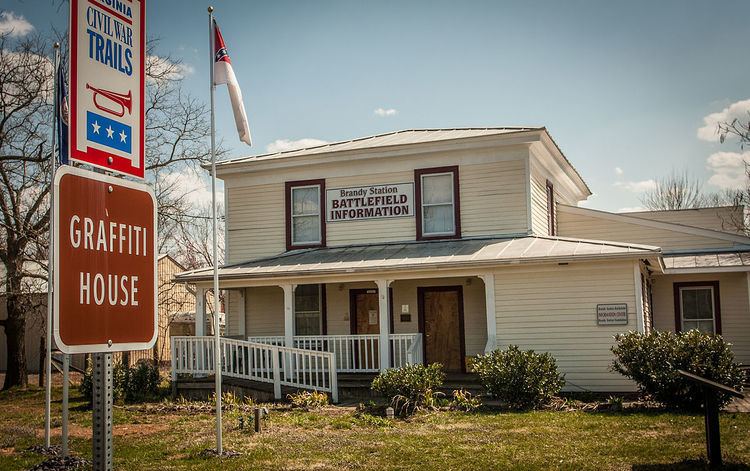Built 1862 VLR # 023-5092 Opened 1862 Phone +1 540-727-7718 | NRHP Reference # 05001274 Designated VLR September 14, 2005 Area 3,642 m² Added to NRHP 17 November 2005 | |
 | ||
MPS Civil War in Virginia MPS Address 19484 Brandy Rd, Brandy Station, VA 22714, USA Hours Closed today FridayClosedSaturday11AM–4PMSunday11AM–4PMMondayClosedTuesdayClosedWednesdayClosedThursdayClosed Architectural style Greek Revival architecture Similar Culpeper National Cemetery, Great Smoky Mountains, Great Smoky Mountain, Historic Blenheim, The Museum of Culpeper | ||
The graffiti house in brandy station virginia paranormal investigations
The Graffiti House, located at 19484 Brandy Road in the eastern end of the town of Brandy Station, Virginia, is believed by the Brandy Station Foundation to have been built in 1858. It is one of few dwellings in the village built before the American Civil War to survive intact to this day. The house is notable because of the Civil War era graffiti on many of the walls. The graffiti found includes names, drawings, names of units, and inscriptions left by soldiers.
Contents
- The graffiti house in brandy station virginia paranormal investigations
- History
- Graffiti that have been identified
- Notes on the names
- Units separately identified
- Events and locations identified
- Drawings
- References
History
Because of its location on the Orange & Alexandria Railroad and the Carolina Road, the house, which was less than 0.25 miles (0.40 km) from the train depot, is thought by the Foundation to have been a commercial building as well as a dwelling. The Foundation reports that some graffiti has been removed or destroyed but considerable graffiti still remain. New graffiti were discovered as recently as December 2010.
The house was owned James Barbour (brother of the railroad's president John S. Barbour Jr.) during the Civil War but the Barbour family's main residence was on a ridge about 1.5 miles (2.4 km) to the south (and during the war was used by Confederate General J.E.B. Stuart). Barbour served on the staff of Lieutenant General Richard S. Ewell until January 1863.
Because of its strategic location near the railroad, this house was used extensively by both the Union Army and Confederate States Army throughout the Civil War. Confederates used it as a field hospital during the Battle of Brandy Station and at other times when battles occurred in the area. It was probably used as a field hospital for wounded soldiers evacuated by train after the Battle of First Bull Run or First Manassas. The earliest known graffiti in the house date to the Second Manassas Campaign in August 1862, as the armies transited Culpeper County.
At the outset of the Gettysburg Campaign, the Battle of Brandy Station, the largest cavalry battle ever to take place in North America occurred on June 9, 1863 in the fields adjacent to the Graffiti House and extended to the heights on which the main house stood. After the fighting ended, the lower house was used as a Confederate field hospital. Later that year, Federal troops occupied the building when the Army of the Potomac camped in Culpeper County during the winter of 1863-64. The house was headquarters to Brigadier General Henry Prince, a division commander in the Third Corps of the Army of the Potomac during the Union Army pursuit of the Army of Northern Virginia after its retreat from the Battle of Gettysburg, sometimes called the Rapidan campaign but this name could be confused with the beginning of the Overland Campaign, and during the Mine Run Campaign later in 1863.
The plaster walls on the house's second floor are covered with an outstanding and unique collection of charcoal and pencil graffiti left by soldiers from both armies. In addition to their autographs, the soldiers drew elaborate pictures of men and women, and wrote inscriptions commemorating their units and their battles. After the war, new paint and wallpaper led to their being forgotten. The graffiti were rediscovered during a renovation in 1993. The Brandy Station Foundation purchased the house in 2002, and its website lists the days it is open for viewing. The house includes a small museum and serves as a headquarters for the Brandy Station Foundation and the Foundation's visitor center for the Brandy Station battlefield.
Graffiti that have been identified
Below is listed the names and units of those who have been identified in the Graffiti House:
Below is listed the names of those who have not been identified in the Graffiti House:
Notes on the names
It is likely that he signed the walls of the Graffiti House while serving in the 24th Battalion Partisan Rangers.
Units separately identified
Events and locations identified
Drawings
Of the drawings found, only two have been identified:
